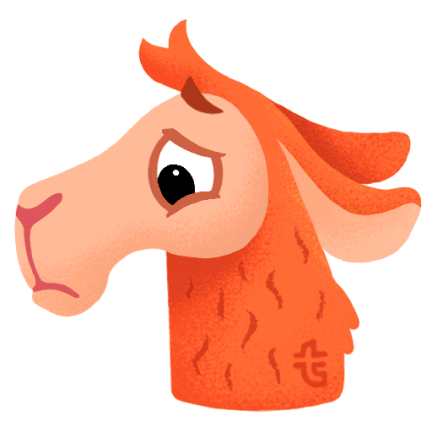About event
In 2018, 53% of Jetradar bookings were made from mobile devices, and this number continues to grow. In this post, Alex Drobson, Head of Global Business Development at Go Mobile, shared the best mobile marketing practices and told us why an app is more advantageous than a mobile website, what are the best ways to build an application, how to avoid common mobile marketing mistakes, and much more.
Mobile and travel statistics
Almost half of all worldwide smartphone users plan a trip, buy air tickets, and reserve a hotel on their mobile device. While in Europe and Australia, this share hasn’t exceeded 50%, developing countries show a much higher rate. For instance, Brazil and India boast 67% and 87% respectively.
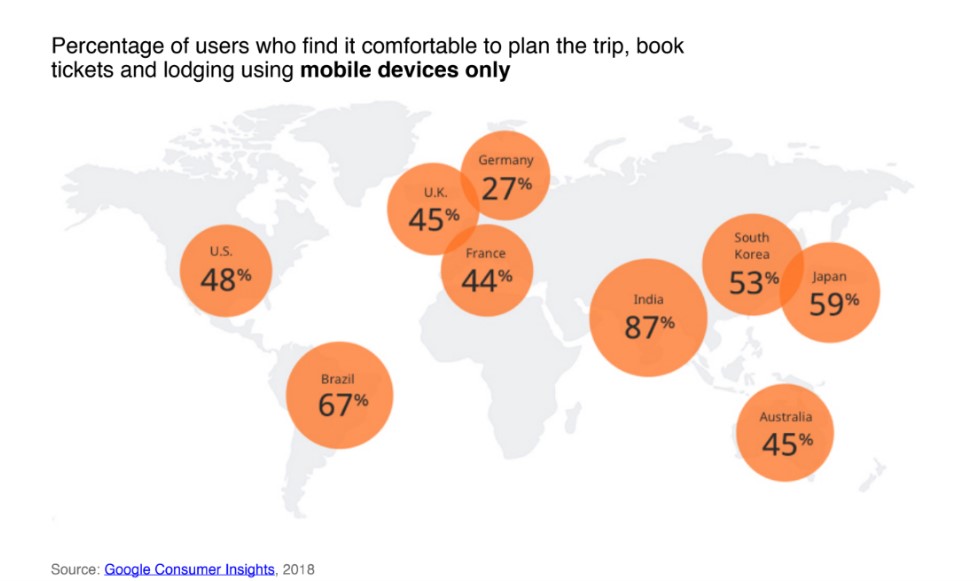
Meanwhile, more than half of B2B business representatives booked a business trip through their mobile device. Two-thirds of travelers have at least one travel app installed on their smartphone and almost 70% use it on a regular basis. Furthermore, 89% of all last-minute bookings were made on a mobile device.
In the diagram below, you can see what kind of apps travelers use and how often they do so.
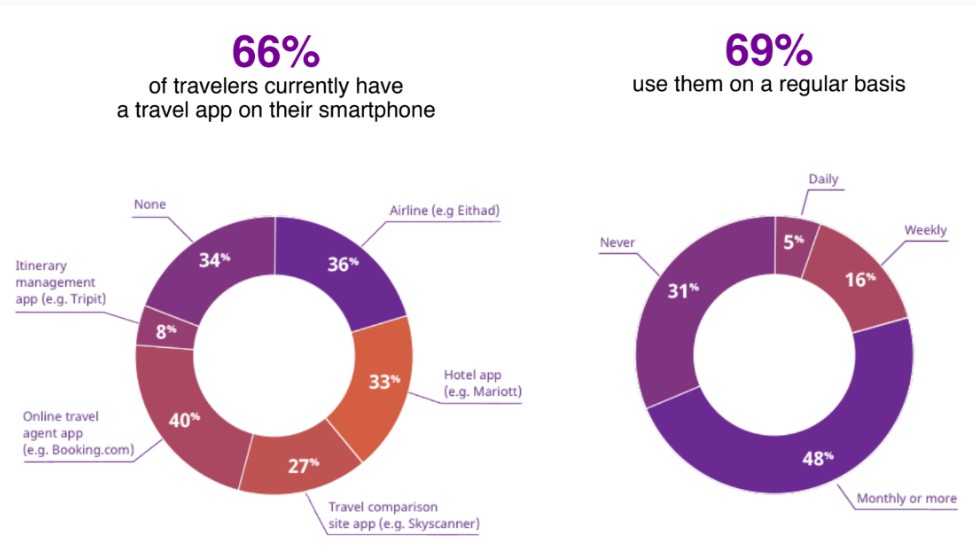
Many clients prefer apps over mobile websites due to:
- Speed
- Push Notifications (seen as spam on the web)
- Extended functionality
- Offline access
Mobile website vs. Mobile application
So, why do clients prefer applications over websites? Here are the main factors:
- It’s fast and easy to access to information, even offline
- No need to login every time
- Special promos, discounts, and news
As for brands, there are a few reasons why they prefer apps as well:
- Easier to get personal data with the current legislation
- Higher conversion rate (6% on mobile in contrast to 2% on desktop)
- Higher average order
- Push notifications serve as a free communication channel
- Loyalty
- Offline integration
Mobile website
A mobile website provides more opportunities for business. Below, there is a quick guide from Google to test the mobile-friendliness of your website.
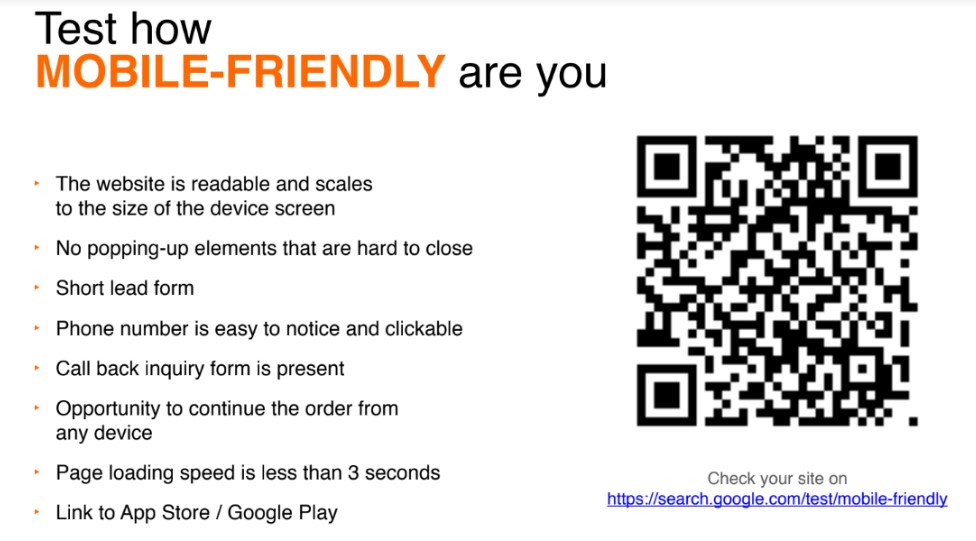
Mobile application
If you don’t have any prior experience, developing a mobile app can be quite complicated, but there are still some ways to get it done.
Agency
This method is advantageous in many ways:
- You sign a contract and receive access to a dedicated team of experts
- You’ll be able to monitor the process the entire time
- The developed app will be your exclusive property
Agencies are interested in long-term relationships, so they’ll provide you with technical support and update the app later on if doing so is stipulated in your contract. There is only one drawback, the price. Even a simple application will cost around $6,000.
Freelancer
This is the cheapest and most painful way to create an app. Freelancers usually receive hourly payments (around $20 per hour) and are likely to extend the number of hours, so make sure to discuss this in advance. You might need to hire other experts, such as a designer or copywriter, which will entail additional expenses.
Lack of a contract might result in you losing time if the freelancer fails to fulfill the task. It is also difficult to perform revisions and updates, as the next contractor will likely rewrite the code from scratch instead of fine-tuning it. Finally, you’ll have to test the app yourself and report bugs to the contractor.
Travelpayouts’ mobile marketing features
Using Travelpayouts, you can earn on flight tickets, hotel reservations, and other travel services. There are a few ways to do it, which are available to both beginners and experienced webmasters:
- Send traffic to the mobile version of Jetradar/Hotellook:
Jetradar receives over half of their traffic from mobile devices. There is also a great conversion rate from searches to sales. This is a good option for anyone with good mobile traffic in the travel niche. Before you start, make sure to check the allowable and forbidden traffic.
- Send traffic to the official Jetradar/Hotellook applications:
You can send traffic from your project to those applications (available for both iOS and Android). Once a user installs one of these apps using your link and starts making purchases, you’ll receive a commission for each purchase. Cookie lifetime is 30 days.
- White Label app:
After registering with Travelpayouts, you can set up the White Label app in your user dashboard and alter it to match your needs (change the logo, name, etc.) From there, you’ll receive a unique link to share with your audience. They’ll install the Travelpayouts White Label application on their end and all purchases made through the app will be attributed to you.
- Create your own app with Travelpayouts SDK:
You can embed Travelpayouts SDK into a currently existing app or create an application from scratch. With SDK, you won’t be corrected by any White Label or other solutions and can build a standalone project which can later be deleted from the store. However, passing through moderation might be tricky, as there are many SDL-based apps today. Here are some tips on how to pass:
- Customize SDK
- Build-in additional functionality
- Discuss challenges with your reviewer
- WebView
Another great solution for your app is WebView. Basically, you can pack your website into an app. This is a budget option that doesn’t require any technical skills.
Below, you can see cost estimates of app development.
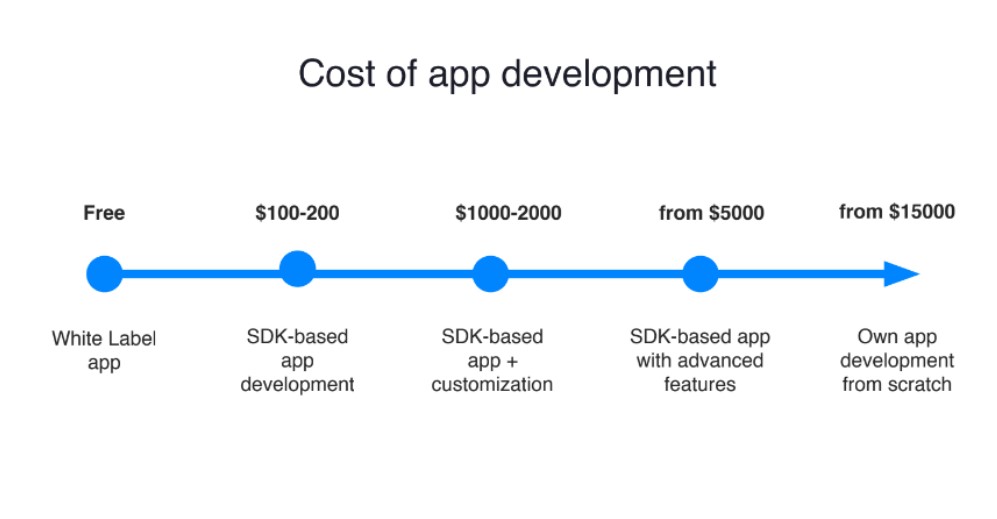
Best practices for working with Travelpayouts in the mobile niche
- Follow the rules.
- Bring value to your users. For example, instead of just building an app for booking air tickets, add leisure recommendations and more.
- Think globally. The English market is already highly competitive, but other markets are no less profitable. For example, Saudi Arabia and the UAE always yield a high average check.
- Regularly update your app (at least once every two-three months). This is important for both app store optimization and for your users. The market develops fast and if you stop performing updates, you’ll quickly lose your position.
Mobile application usability
Here are a few insights into how to increase the usability of your application and avoid common mobile marketing mistakes.
Design
Tailor your design to your target audience. For example, for adult travelers, use large text and no more than two fonts, make all your buttons large, and use two bright colors supported with neutral shades. If you have both a mobile website and application, make their designs look as similar as possible.
Navigation
All buttons should be clear. The best way is to follow the guides from Apple or Google Play. Make sure to add features for canceling actions and returning to previously canceled ones. Swiping is considered the best navigation method. Thus, adding this option might help achieve better user onboarding.
Forms and data
- Don’t ask users for registration if doing so isn’t necessary.
- Integrate any logins with social media. Facebook is usually enough.
- Forms should be as short as possible.
- Allow automatic fill-in of personal data, such as name, surname, email, etc.
- Provide quick comments for form completion.
- Set up saving of completed fields when the page is reloaded.
- Add drop-down lists.
- Allow for the ability to save search inquiries.
Onboarding
Onboarding serves as a quick guide on how to use an application and should appear only during the first app launch. Try to not include too many tips that are obvious for general app users and remember to add a help section to your main menu.
Here are some additional tips:
- Adjust push-notifications, but be sure to segment them based on data gathered from your app.
- If you need a user’s location, ask for it. It is easier to ask the user to enter their location than to ask for it during each app launch.
- Make a free version of your app with all the basic features.
- Don’t use pop-up ads or annoying full-screen videos.
- Show native ads.
- Allow users to send feedback through a special form.
Mobile advertising
These are the key performance indicators (KPS) to estimate your campaign with:
- Cost per user/install
- Retention rate (how many days people use the app for)
- User engagement
- Overall profitability
Remember that these KPIs vary based on industry.
Promote your app or mobile website using various channels, such as Facebook, Instagram, Google, Twitter, etc. After mastering these platforms, look into local providers of special features and mobile networks.
Explore various targeting options, such as social demographics, income level, interests, installed applications, operator, smartphone model, browser language, type of connection, etc.
Creative materials
It’s important to understand your target audience and come up with as many creative materials as possible to try different approaches. Here are the main principles:
- Think about your users and align your vision toward business with them.
- Don’t think solely about performance. If your product is new, think about awareness as well.
- Learn and test. Once you’ve created ten pieces of creative content with different messages for different audiences, you’ll see which converts better and dive deeper into that segment.
- Move from easy to complex. Make standard banners, see what works well, and, once you have the budget for more complex creative content, step up the complexity.
- Don’t promise your users something that you won’t be able to deliver. If you work with an agency, make sure to maintain control of all creative materials. If you promise something super sweet that you cannot deliver, the cost per click will be very low, but the conversion rate will be even lower.
Media-buying models
Basically, you can buy clicks (Cost Per Click or CPC) or impressions (Cost Per Impression). CPM implies paying for each 1,000 displays of an advert. Below are some of the basic payment models:
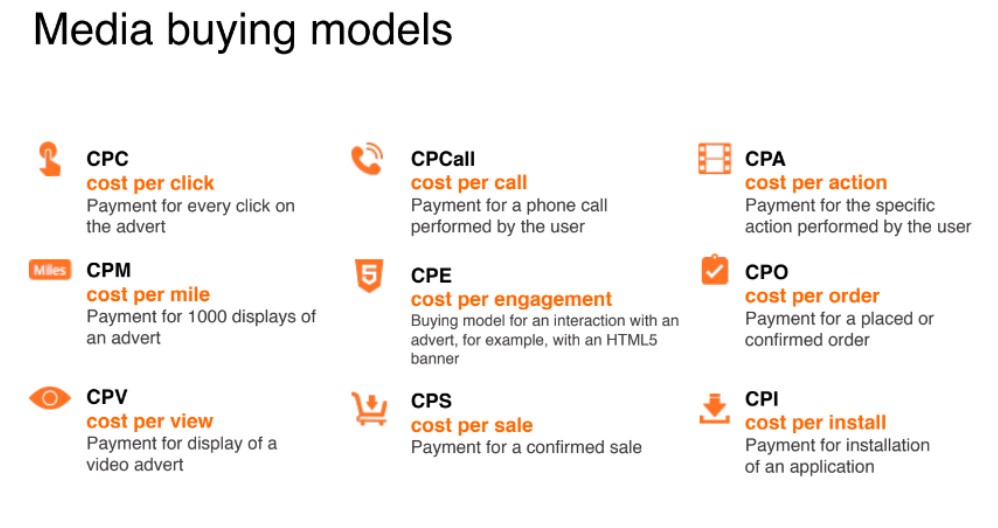
If you’re currently working with an agency and paying for clicks, ask if they are ready to commit to actions or orders. If not, maybe you should start looking for another agency.
Pricing factors
An order can cost anywhere from less to $10 to $1,000,000 depending on the promotional channel, target audience, and other factors. A quick checklist regarding pricing:
- Make sure you position your product correctly and clearly select your target audience and goals
- Analyze the activity of your competitors
- Audit your own assets: usability, UX, channels, tools, etc.
- Update ASO and promotion channels
- Pay attention to segmentation and tools, as well as creative concept and production
- Launch campaigns and optimize them with analytical tools
ASO
App store optimization (ASO) aims to help your application gain trust from users and increase the conversion rate (CR) from application page views into installs. Here are the main parts of ASO:
- Text optimization. Make sure to include strong keywords and express the benefits of your app.
- Visual optimization. Pick the most appealing screens and features of your app and describe their key benefits using text on a single-color background.
- Video: This can be as simple as an animated video, no longer than 30 seconds, explaining how to use the app and its benefits.
- Ratings and reviews. To achieve high conversion, your rating should be higher than 4.5. The best way is to get organic reviews from your users is to ask for a review once a specified action is completed.
- Keyword promotion. Include as many keywords as possible. Research your competitors to find strong keywords.
To avoid common mistakes in mobile app marketing: don’t purchase reviews, make use of free analytics tools that have all the necessary features, and don’t overpay for videos or photos, as you can find high-quality materials for free.
ASO differs for Google Play and the App Store. Google Play pays close attention to copywriting quality, but features many other ranking factors as well. You can also do split-tests for free in contrast to the App Store.
For the App Store, it is crucial to find the right (narrow) keywords and use additional locations, each one giving +100 symbols for keywords. Don’t forget to update your ASO for holidays and events. This can have a great effect on conversion in both stores.
When localizing an app, consult with local copywriters not only about the language, but even about the design and other details. If you target Europe, English is not enough. For instance, French and Italian users don’t like to use apps in English. If you localize into Hebrew/Arab, make sure to mirror the entire application. Finally, there are not many basic locations, so use special crossing maps.
Trends
To make your efforts more financially efficient, follow mobile marketing trends. You can see the results of the Go Mobile’s research in the graph below:
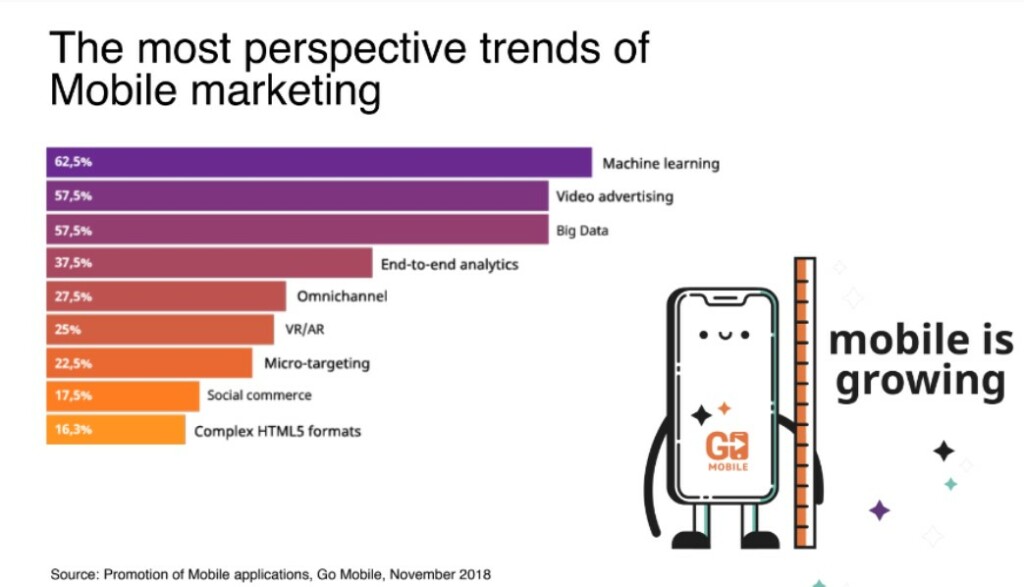
How to succeed in mobile marketing
With more bookings being made on mobile devices, companies are starting to allocate larger budgets to mobile marketing. Users prefer apps because of their speed, comfort, offline access, etc. You can develop an app on your own, use White Label or Travelpayouts SDK, or create one with the help of an agency or freelancer. Once the application is ready, remember to work on usability, constantly update the app, and make use of ASO.
What will you learn
- Do you really need an app or is a website enough?
- When should you start thinking about mobile marketing in your branding strategy?
- What is the proper adaptive web design (AWD)?
- What is the difference between ASO in Google Play and the App Store?
- How can you get the maximum from ASO without huge budgets?
- What is mobile app usability?
- How can white-label apps avoid being banned?
Speakers





